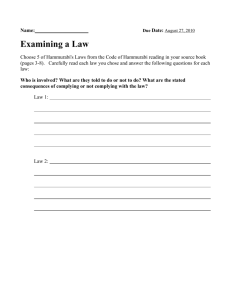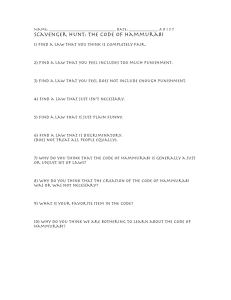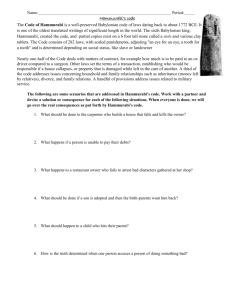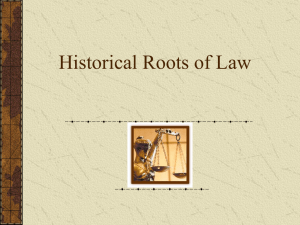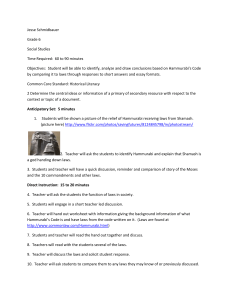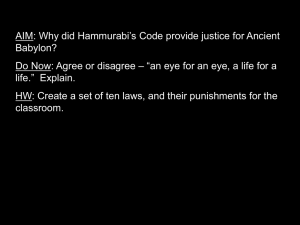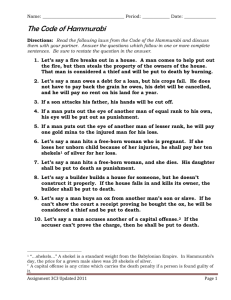Record your thoughts in your notebook!
advertisement
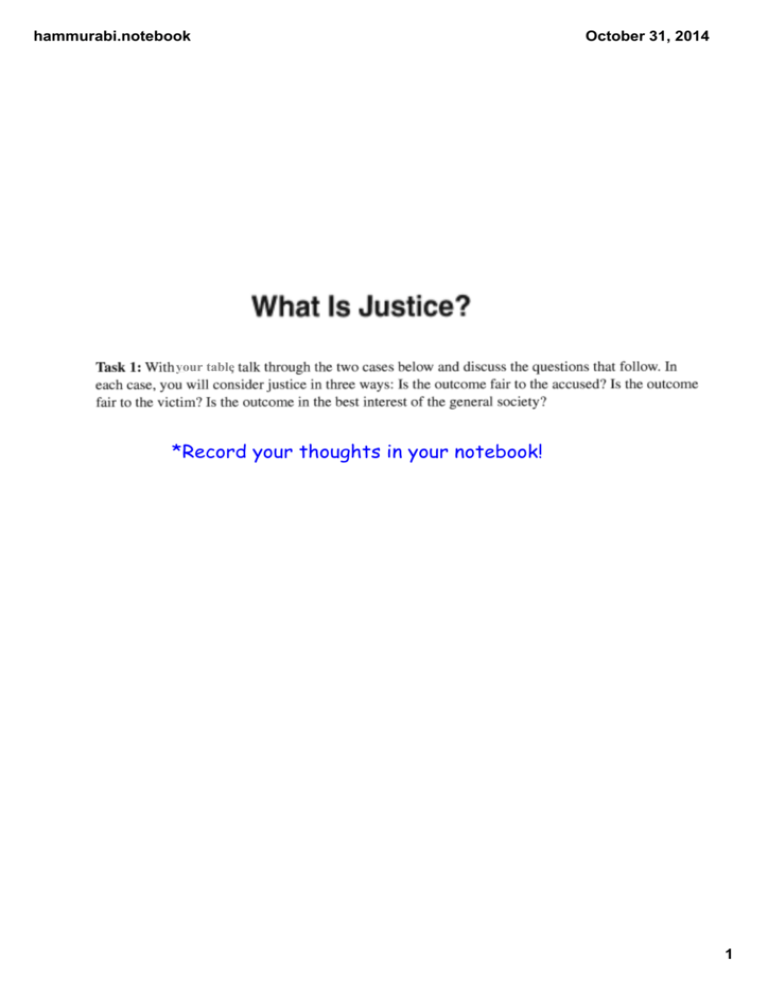
hammurabi.notebook October 31, 2014 your table *Record your thoughts in your notebook! 1 hammurabi.notebook October 31, 2014 2 hammurabi.notebook October 31, 2014 3 hammurabi.notebook October 31, 2014 4 hammurabi.notebook October 31, 2014 "An eye for an eye, and a tooth for a tooth" 5 hammurabi.notebook October 31, 2014 Very little is known about Hammurabi ***don't know his birth, death, family, or physical characteristics All we know about him comes from his clay writing tablets A) We know he ruled for 42 years, mostly over the city­state of Babylon B) By the end, his reign extended over most of the Mesopotamian region C) Eventually, his kingdom had around 1,000,000 people (mostly farmers) By the 38th year of his rule, Hammurabi carved 282 laws onto large, pillars of stone called Stele. This is now known as "The Code of Hammurabi." A) Historians believe he had these placed around the town for all to see B) We can learn much about daily life from these pillars *For example, 3 classes of people: land owners, free people, and slaves C) We can also learn about the problems that people dealt with at this time *For example, buildings collapsing and neighbors arguing D) Hammurabi's main goal: to bring justice to all 6 hammurabi.notebook October 31, 2014 7 hammurabi.notebook October 31, 2014 8 hammurabi.notebook October 31, 2014 Hammurabi's purpose was to provide protection for all people and to have justice for all. The god Shamash (god of heaven and earth commanded him to create the monument. Any king who does not follow his laws will be cursed, as will his family and people of the land. It is just (fair) because he provides protection for everyone, and the strong cannot injure the weak. It was unjust (unfair) because people are getting punished even if they did not break the law. 9 hammurabi.notebook Group A October 31, 2014 strong central government created by recording legal decisons from old Sumerian laws given to him by the god Shamash explains how legal matters should be addressed humans can give out punishments, instead of gods Strict penalties for not following legal process The idea of justice is no longer from the gods­ humans deal out punishments Punishments were designed to fit the crime Punishments were dealt out by social status and class­ fair laws, but not equal laws 10 hammurabi.notebook October 31, 2014 Group B They were harsh and severe. There was little room for second chances. People were motivated to behave properly and follow the rules. Hammurabi protected the rights of women, farmers, businessmen, and he wanted to make sure that the strong did not injure the weak. Make your own decision and use evidence to support Make your own decision and use evidence to support 11 hammurabi.notebook October 31, 2014 Group C *Read ONLY the sections labeled "An Eye for an Eye," "No Joke!," and "The Desire for Justice." 1) In what ways was the code "Progressive?" 2) What does "trial by ordeal" mean? How does it apply to Hammurabi's Code? 3) How does Hammurabi seek to provide justice? 1) The code was progressive because it gave rights to women, farmers, slaves, and other people who did not normally receive protection in their civilizations. 2) Trial by ordeal means that, when a judge cannot decide guilty or innocent, a process is ordered to take place. For example, Law 2 of Hammurabi's Code states that a person in thrown into the river to see if they are innocent. If they sink, they were guilty and if the survive, they are innocent. It is left up to the gods to decide. 3) Hammurabi seeks to provide justice by destroying the evil and wicked-doers. He wanted everyone to be protected. He declared that humans are now responsible for dealing out consequences and punishments, instead of the gods, except for cases where humans cannot decide. 12 hammurabi.notebook October 31, 2014 13 hammurabi.notebook October 31, 2014 Cuneiform, wedged shape writing The Prologue, The Epilogue, and the Laws (282 of them) The god Shamash­ the great god of justice­ and all the gods Draw your own conlcusions Draw your own conclusions 14 hammurabi.notebook October 31, 2014 See Next Slide See Next Slide 15 hammurabi.notebook October 31, 2014 16
